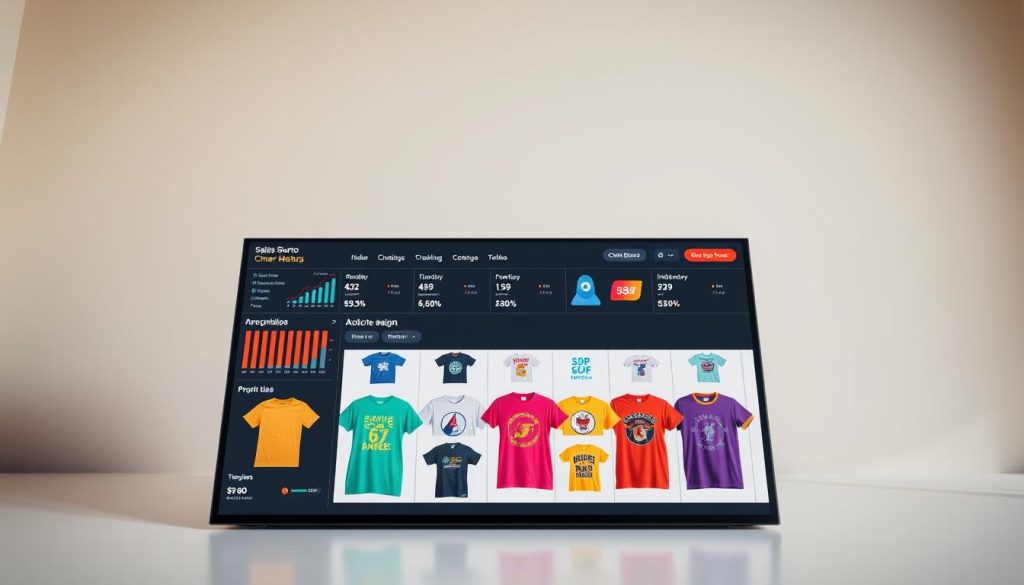Did you know that the global print-on-demand market is expected to reach a staggering $10 billion by 2025? This explosive growth offers a golden opportunity for aspiring entrepreneurs to dive into the *print-on-demand in 2025* realm and start an *online t-shirt empire* without the burden of inventory management.
In this article, we’ll explore how the latest advancements in technology and shifts in consumer demand make 2025 the perfect year to *launch* your very own t-shirt business completely *online* and inventory-free. We’ll guide you through understanding the *print-on-demand business model*, selecting your niche, setting up your store, and creating eye-catching designs that capture market interest.

Key Takeaways
- The print-on-demand market is projected to hit $10 billion by 2025.
- Entrepreneurs can start their online t-shirt empire with no inventory costs.
- Technological advancements make 2025 the perfect year for a POD launch.
- Understanding the print-on-demand business model is crucial for success.
- Key steps include choosing a niche, setting up an online store, and crafting unique designs.
- Understanding Print-on-Demand Business Model
- Why 2025 is the Perfect Year to Start Your Print-on-Demand Business
- Choosing the Right Niche
- Top Print-on-Demand Platforms in 2025
- Creating Eye-Catching T-Shirt Designs
- How to Set Up Your Online T-Shirt Store
- Optimizing Your Product Listings for SEO
- Marketing Strategies for Your T-Shirt Empire
- Print-on-Demand in 2025: How to Launch Your Online T-Shirt Empire with No Inventory
- Managing Customer Service and Engagement
- Scaling Your Business for Growth
- Understanding Tariffs and Regulations in 2025
- Monitoring and Improving Your Store’s Performance
- Common Mistakes to Avoid in Your Print-on-Demand Business
- Success Stories: Entrepreneurs Who Thrived with Print-on-Demand
- Future Trends in Print-on-Demand and Custom Apparel
- Conclusion
- FAQ
- What is Print-on-Demand?
- What are the benefits of Print-on-Demand for entrepreneurs?
- Why is 2025 the perfect year to start a Print-on-Demand business?
- How can I identify my target audience for a custom apparel business?
- Which platforms are top choices in the Print-on-Demand market in 2025?
- How can I create eye-catching t-shirt designs?
- What steps are involved in setting up an online t-shirt store?
- How can I optimize my product listings for SEO?
- What marketing strategies are effective for a print-on-demand t-shirt business in 2025?
- How should I manage customer service and engagement?
- What strategies can help scale a print-on-demand business for growth?
- How important are tariffs and regulations in 2025 for a print-on-demand business?
- How can I monitor and improve my store’s performance?
- What are common mistakes to avoid in a print-on-demand business?
- Can you share success stories of entrepreneurs in the print-on-demand industry?
- What future trends are anticipated in the print-on-demand and custom apparel industry?
Understanding Print-on-Demand Business Model
In the evolving world of ecommerce, one standout model that’s gaining traction is the print-on-demand business model. This approach enables entrepreneurs to create products only after a sale has been made, thus eliminating the need for inventory. This is particularly advantageous given the current ecommerce trends, as it allows for more flexibility and reduced financial risk.
What is Print-on-Demand?
Print-on-demand is an innovative model in which items are produced only when an order is placed. This ensures that you, as a business owner, don’t have to invest in bulk inventory. The print-on-demand business model is perfectly aligned with business growth strategies that emphasize low overhead and high adaptability. It eliminates the burden of managing unsold stock, making it an ideal strategy for budding entrepreneurs looking to test new designs or limited edition releases without financial strain.
Benefits of Print-on-Demand for Entrepreneurs
There are numerous benefits that make the print-on-demand business model appealing to entrepreneurs. Here’s a detailed look:
| Benefit | Description |
|---|---|
| Reduced Overhead | Since products are only created after a sale, there is no need to invest in large inventories, significantly decreasing storage costs. |
| Wide Range of Designs | You can offer an extensive array of designs without any extra costs, allowing greater variety and customer appeal. |
| Agility in Market Testing | Quickly test and adapt to market trends without facing financial losses. This agility can be a crucial element in business growth. |
| Scalability | Easily scale your business operations as demand grows without the complexities involved in traditional models. |
These benefits underscore why the print-on-demand business model is an excellent choice for modern entrepreneurs who are keen on leveraging the latest ecommerce trends to drive business growth.
Why 2025 is the Perfect Year to Start Your Print-on-Demand Business
As we approach 2025, the print-on-demand industry is poised for unprecedented growth and transformation. Recent technological advancements are revolutionizing the way businesses operate, making it easier than ever for entrepreneurs to launch and scale their custom apparel ventures.
Technological Advancements
The advancements in digital printing technology have significantly lowered the entry barriers for new business owners. High-quality printing is now accessible, allowing entrepreneurs to produce custom apparel with exceptional detail and vibrant colors. Moreover, enhanced ecommerce platforms streamline the entire process from order management to fulfillment, providing a seamless experience for both sellers and customers.
Market Growth and Demand
The market growth for custom apparel continues to soar as consumers increasingly seek unique and personalized clothing items. Modern consumers want to express their individuality through fashion, and custom apparel provides the perfect avenue for this. With the continuous rise in demand, savvy entrepreneurs have a golden opportunity to tap into this lucrative market and build successful print-on-demand businesses.
The blend of cutting-edge technology and the robust demand for distinctive apparel creates an ideal ecosystem for new entrepreneurs. By leveraging these technological advancements and catering to the growing desire for custom apparel, 2025 stands out as the optimal year to embark on your print-on-demand journey.
Choosing the Right Niche
Effective niche selection is a cornerstone of a successful print-on-demand business. There are two critical steps in this process: identifying your target audience and researching niche trends. This involves understanding who your potential buyers are and what specific interests they might have. With these insights, you can tailor your products to meet their needs.
Identifying Your Target Audience
Identifying your target audience starts with understanding their demographics, interests, and purchasing behavior. It is essential to know who your potential customers are to create products that resonate with them. Consider factors such as age, gender, location, and hobbies. By defining these attributes, you can craft marketing messages and designs that appeal directly to them.
Researching Niche Trends
Once you’ve identified your target audience, the next step is researching niche trends. This involves analyzing social media trends, customer feedback, and market data. Platforms like Instagram, Pinterest, and Twitter are excellent for spotting emerging trends within specific niches. Additionally, reviewing customer feedback on popular ecommerce sites can offer valuable insights into what products are currently in demand. Keeping up to date with these trends helps predict what will be successful in the market.
| Factors | Description |
|---|---|
| Demographics | Age, gender, location, and other personal attributes of your target audience. |
| Interests | Hobbies, passions, and activities your audience enjoys. |
| Trends | Current popular topics and themes within your niche. |
| Feedback | Customer reviews and comments that offer insights into preferences. |
Top Print-on-Demand Platforms in 2025
As the print-on-demand industry continues to expand in 2025, selecting the right platform becomes crucial for success. Top platforms like Printful, Printify, and Redbubble stand out due to their robust features and user-friendly services. These platforms provide comprehensive solutions that cater to the varied needs of online t-shirt businesses.
Printful
Printful is well-regarded for its high-quality printing and diverse product range. Entrepreneurs can easily integrate Printful with popular e-commerce platforms, streamlining the order fulfillment process. Their worldwide shipping capabilities make them a reliable choice for global business operations.
Printify
Printify offers a flexible and extensive network of print providers, providing users with the ability to choose the best provider based on product type and location. This versatility, coupled with competitive pricing, makes Printify one of the top platforms for those seeking efficient cost management and varied printing options.
Redbubble
Redbubble is renowned for its unique marketplace, offering an excellent opportunity for artists and designers to showcase their work. With a dedicated following and effective marketing tools, Redbubble helps users tap into a vast customer base, fostering business growth and brand recognition.
By leveraging the strengths of Printful, Printify, and Redbubble, entrepreneurs can effectively launch and scale their print-on-demand businesses. Each of these top platforms offers unique advantages that cater to different aspects of business needs, ensuring a successful venture in the competitive landscape of 2025.
Creating Eye-Catching T-Shirt Designs
Designing appealing t-shirt graphics is crucial to the success of your print-on-demand business. Leveraging advanced design tools and resources can elevate your creations, making them stand out in a competitive market. However, if you’re not adept at graphic design, outsourcing design work to professionals is a viable option to ensure you get high-quality and market-relevant designs.
Using Design Tools and Resources
The digital age offers a myriad of design tools that cater to varying skill levels, making it easier than ever to create stunning visuals. Applications like Adobe Illustrator, Canva, and Procreate provide extensive libraries of templates, fonts, and elements, allowing you to bring your creative ideas to life. Whether you are a beginner or a seasoned designer, these tools can significantly enhance your artistic capabilities.
Moreover, resources such as Creative Market and Envato Elements offer a treasure trove of design assets including mockups, textures, and vector illustrations. Utilizing these resources can not only save time but also inspire new concepts for your t-shirt designs, ensuring they resonate with your target audience.
Outsourcing Design Work
For those who may not have the time or skills to create their own designs, outsourcing design is an effective strategy. Platforms like Upwork and Fiverr connect you with skilled designers from around the world. By providing a detailed brief, you can ensure that the outsourced work aligns with your vision and brand identity. Additionally, this approach allows you to tap into diverse artistic skills and unique design perspectives, enriching your product offerings.
Another advantage of outsourcing design is the ability to scale up your design capabilities without investing in expensive software or extensive training. This is particularly beneficial for entrepreneurs looking to quickly expand their product line and meet the evolving demands of their customers. By integrating high-quality designs with state-of-the-art digital printing technologies, you can create a distinct and professional brand image.
How to Set Up Your Online T-Shirt Store
Setting up your own online t-shirt store can be a highly rewarding venture. However, it requires careful planning and a good understanding of the tools available to you. An essential part of the store setup process involves choosing a suitable ecommerce platform and configuring the necessary settings to ensure a smooth user experience for your customers.

Choosing an Ecommerce Platform
The first step in the store setup process is to select an ecommerce platform that meets your business needs. Popular choices include Shopify and Etsy, both of which offer robust integration with print-on-demand services. Shopify, for instance, is known for its user-friendly interface and extensive app store that allows for easy customization. On the other hand, Etsy provides a marketplace that already attracts millions of visitors interested in handmade and unique items.
Configuring Your Store Settings
Once you’ve selected your ecommerce platform, it’s time to configure your store’s settings. This includes setting up payment gateways to handle transactions securely, organizing your products into clear categories, and designing a user-friendly interface that enhances the overall shopping experience for your customers. Elements like clear navigation menus, high-quality photos, and accessible customer service sections are crucial for the success of your online store.
Optimizing Your Product Listings for SEO
Maximizing visibility for your online t-shirt store involves mastering SEO optimization for your product listings. Effective SEO can elevate your listings in search engine results, attracting more eyes and potential customers. Start by focusing on a few key areas.
Crafting Engaging Product Titles
Crafting engaging titles is crucial for grabbing attention and improving your SEO optimization. A well-crafted title should be descriptive yet concise, including relevant keywords without sounding forced. For instance, instead of “Cool T-Shirt,” consider “Vintage Style Cool Graphic T-Shirt for Men and Women.” This approach not only appeals to buyers but also enhances product listings visibility.
Writing Detailed Product Descriptions
Detailed descriptions are essential for SEO optimization and providing potential customers with all the information they need. Focus on describing the material, fit, design, and care instructions. Use phrases that potential customers might search for, like “soft cotton t-shirt” or “easy-care breathable fabric.” An informative description helps improve your product listings ranking on search engines.
Utilizing Effective Tags and Keywords
Incorporate effective tags and keywords that are relevant to your product listings. These keywords should mirror what your target audience is likely to search for. Use a mix of broad and specific terms, such as “graphic tee,” “vintage t-shirt,” and “modern fashion.” Properly tagging your products can significantly boost their discoverability on both your ecommerce platform and search engines.
Marketing Strategies for Your T-Shirt Empire
Marketing a print-on-demand t-shirt business in 2025 requires a multifaceted approach. By leveraging social media marketing, running effective paid advertising campaigns, and collaborating with influencers, you can significantly increase your brand’s visibility and drive sales growth.
Leveraging Social Media
Social media marketing is crucial for promoting your t-shirt designs and engaging with your audience. Platforms like Instagram and TikTok are excellent for showcasing new products, sharing user-generated content, and running contests to boost engagement. Moreover, consistent posting and interaction help build a loyal community around your brand.

Running Paid Advertising Campaigns
Paid advertising offers targeted reach to potential customers who might not be aware of your brand. Platforms such as Facebook Ads and Google Ads allow you to create campaigns that target specific demographics, interests, and behaviors. This ensures that your marketing efforts are seen by those most likely to convert into paying customers, maximizing your ROI.
Collaborating with Influencers
Influencer collaborations can amplify your brand’s reach and credibility. Partnering with influencers who have a significant and engaged following in your niche can lead to increased brand awareness and trust. Influencers can showcase your products in a relatable and authentic manner, driving their followers to check out your t-shirt store.
Print-on-Demand in 2025: How to Launch Your Online T-Shirt Empire with No Inventory
The year 2025 presents an unparalleled opportunity to launch an online t-shirt business using the no inventory business model. Technological advancements, combined with the burgeoning market demand for customized apparel, make it a ripe time to dive into the print-on-demand world. By leveraging this model, entrepreneurs can effortlessly start their t-shirt business without worrying about inventory management, which has traditionally been a major barrier.
One of the primary advantages of the no inventory business model is the dramatic reduction in initial costs. Without the need to pre-purchase large quantities of stock, startups can allocate their resources towards marketing, design, and other critical areas of their business. This financial flexibility is especially crucial in the competitive landscape of 2025.
Moreover, advances in printing technology have greatly enhanced the quality and speed of producing print-on-demand t-shirts. High-resolution prints, vibrant colors, and durable fabric options are now standard, ensuring customer satisfaction and repeat purchases. These technological strides mean that even smaller players can produce high-quality merchandise that rivals established brands.
To effectively launch an online t-shirt business in 2025, entrepreneurs must also capitalize on market trends and consumer preferences. Current data indicates a growing demand for personalized and unique apparel, driven by a culture that values individual expression and stands against fast-fashion. Catering to niche markets and offering exclusive designs can significantly boost a business’s visibility and profitability.
Lastly, the digital ecosystem in 2025 is more favorable than ever for ecommerce ventures. Social media platforms, influencer collaborations, and advanced digital marketing tools provide ample opportunities to reach and engage a global audience with minimal effort. With the right strategy, even a newly launched online t-shirt business can achieve rapid growth and substantial market presence.
In conclusion, leveraging the no inventory business model to launch an online t-shirt business in 2025 is a strategic move that minimizes risk while maximizing potential. By taking advantage of modern technology, market trends, and digital marketing strategies, aspiring entrepreneurs can set themselves up for success in the thriving world of print-on-demand.
Managing Customer Service and Engagement
Effectively managing customer service and customer engagement is crucial for the success of your print-on-demand t-shirt business. Timely and efficient handling of customer inquiries, returns, and refunds are paramount in building a solid reputation and fostering trust with your customers.

Responding to Customer Inquiries
Promptly responding to customer inquiries can significantly enhance customer engagement. According to recent studies, customers expect a response within 24 hours. Streamlining this process with automated email responses or chatbots can be beneficial, ensuring your customers feel valued and heard.
Handling Returns and Refunds
Handling returns efficiently is a critical aspect of customer service. Offering a simple and transparent return policy can help mitigate customer dissatisfaction. Implementing a hassle-free process not only improves customer retention but also positively impacts your brand’s reputation.
Encouraging Customer Reviews
Customer reviews play a vital role in building trust and credibility. Encourage satisfied customers to leave positive reviews by sending follow-up emails post-purchase. Offering incentives like discounts on future purchases can also motivate customers to share their feedback, enhancing overall customer engagement.
| Customer Service Management | Key Benefits |
|---|---|
| Responding to Inquiries | Enhances customer engagement |
| Handling Returns and Refunds | Improves customer satisfaction and retention |
| Encouraging Customer Reviews | Builds trust and credibility |
Scaling Your Business for Growth
Taking your print-on-demand business to the next level requires a thoughtful approach to business scaling. By expanding your product line, automating processes, and utilizing data analytics, you can achieve substantial growth and efficiency.
Expanding Your Product Line
Expanding your product line is crucial for reaching a wider audience and enhancing your market presence. Consider adding new apparel types like hoodies, tank tops, and accessories such as hats or tote bags. Diversifying your offerings through product expansion can attract more customers and increase sales.
Automating Processes
Incorporating automation into your operations improves efficiency and reduces manual effort. Invest in automated tools for order processing, inventory management, and customer service tasks. Such automation can save time and focus on strategic growth activities.
Utilizing Data Analytics
Utilizing data analytics is essential for making informed decisions. Track trends, customer preferences, and sales data to optimize your strategies. Use analytics tools to identify popular designs, set competitive pricing, and refine marketing efforts. Data-driven decisions are key to successful business scaling.
| Key Strategy | Benefits | Tools |
|---|---|---|
| Product Expansion | Increased market reach and sales | Market research platforms |
| Automation | Improved efficiency and reduced manual tasks | Order processing software |
| Data Analytics | Data-driven decision making | Analytics tools |
Understanding Tariffs and Regulations in 2025
In 2025, staying updated with tariffs and regulatory frameworks is essential for any print-on-demand business aiming to maintain profitability and ensure lawful operation. Changes in trade policies can significantly influence your pricing strategies and operational expenses.

Impact on Pricing and Costs
Tariffs impact the overall cost structure of your business. For instance, any adjustments in import taxes on raw materials will directly affect your product pricing. It’s crucial to grasp these factors to strategically manage business costs and preserve your profit margins.
Staying Compliant with Regulations
Regulatory compliance is non-negotiable in the print-on-demand industry. Staying versed with international and domestic trade regulations helps avoid legal complications. Prioritizing compliance minimizes operational disruptions and shields you from potential fines.
Monitoring and Improving Your Store’s Performance
Effectively managing your print-on-demand store requires consistent performance monitoring and vigilant analysis of sales and marketing data. By honing in on key metrics, you can identify areas for enhancement and ensure sustained growth.
Analyzing Sales Data
Regular sales analysis is crucial for understanding customer preferences and purchasing behavior. Key metrics such as conversion rates, average order value, and customer acquisition cost provide valuable insights into your store’s health. Utilizing tools like Google Analytics and Shopify’s built-in analytics can streamline this process, allowing you to track performance metrics in real-time.
Optimizing Marketing Efforts
Marketing optimization involves fine-tuning your campaigns to maximize reach and engagement. This can be achieved through A/B testing, refining target audiences, and leveraging data-driven insights. Adjusting your strategies based on performance metrics can lead to more effective ad spend and improved return on investment (ROI).
| Analytical Method | Purpose |
|---|---|
| Google Analytics | Track and analyze website traffic and user behavior |
| A/B Testing | Compare two versions of a web page to determine which performs better |
| Customer Feedback | Gain insights into customer satisfaction and areas for improvement |
By maintaining a regular schedule for performance monitoring and adjusting your strategies accordingly, you can drive continuous improvements in sales and marketing efforts. This proactive approach ensures that your print-on-demand store remains competitive and successful in a dynamic market.
Common Mistakes to Avoid in Your Print-on-Demand Business
Launching a successful print-on-demand business requires attention to multiple facets. Among these, avoiding common business mistakes, ensuring robust quality control, and accurately estimating demand are critical to sustaining long-term growth. Let’s explore these pitfalls and how to steer clear of them for a thriving venture.
Overestimating Demand
One of the frequent business mistakes is overestimating demand. Many entrepreneurs fall into the trap of being overly optimistic about their products’ sales potential. It’s crucial to conduct thorough demand estimation before committing to large-scale production. This prevents overproduction and ensures that the inventory aligns closely with market needs.
Ignoring Quality Control
Quality control is another essential element that should never be overlooked. Consistently high-quality products lead to loyal customers and positive reviews. Ignoring this aspect can damage your brand’s reputation and customer trust. Implementing a stringent quality control process helps maintain your product standards and reduces the risk of returns or complaints.
Avoiding these broad-spectrum business mistakes by focusing on precise demand estimation and unwavering quality control will set a solid foundation for your print-on-demand enterprise.
Success Stories: Entrepreneurs Who Thrived with Print-on-Demand
Diving into the world of print-on-demand can be daunting, but many entrepreneurs have navigated this path successfully. Their journeys are filled with valuable lessons and inspirations for future business owners. Below, we highlight some remarkable success stories and the key business tips they offer.
Case Study: Successful Examples
Teespring: Teespring revolutionized custom apparel by allowing users to design and sell their own merchandise with no upfront costs. This platform enabled countless entrepreneurs to tap into niche markets and create unique product lines, resulting in phenomenal growth and market penetration.
Merch by Amazon: Leveraging Amazon’s vast reach, Merch by Amazon allowed artists and creators to upload their artwork, select product types, and set prices without worrying about inventory or shipping. This ease of access has driven many success stories, including several six-figure annual revenues for dedicated sellers.
Lessons Learned and Tips
From these entrepreneur case studies, we can extract actionable business tips:
- Leverage Niche Markets: Identifying and targeting niche markets can set your brand apart and create a loyal customer base. Tailor your designs and marketing efforts to appeal to these specific groups.
- Utilize Social Media: Social media platforms are powerful tools for promoting your products and engaging with your audience. Create consistent and engaging content to build brand awareness and drive traffic to your store.
- Focus on Quality: High-quality products lead to satisfied customers and repeat business. Ensure your chosen print-on-demand provider maintains strong quality control to deliver outstanding products.
Future Trends in Print-on-Demand and Custom Apparel
As we look forward, the print-on-demand and custom apparel industry is ripe with exciting advancements and progressive changes. Particularly, future trends focus on the remarkable digital printing innovations alongside an amplified commitment to sustainability.
Innovations in Digital Printing
Digital printing has seen some transformative developments, propelling the industry into the future. Enhanced printer technology now offers faster, more precise printing capabilities. These improvements not only streamline the production process but also enable the creation of highly detailed and intricate designs, which were previously unattainable.
Discussing digital printing innovations wouldn’t be complete without mentioning the growing adoption of AI-driven design tools. These tools allow designers to experiment with vast design permutations, ensuring unique and aesthetically pleasing results. Additionally, the introduction of eco-friendly inks aligns with sustainable practices, catering to the growing demand for environmentally responsible products.
Sustainability and Eco-Friendly Options
The apparel industry has been making strides to incorporate more sustainable practices. From adopting organic fabrics to utilizing water-based inks in digital printing, the focus on sustainability is stronger than ever. Consumers are increasingly aware of their environmental footprint, pushing brands to prioritize eco-friendly options.
Another notable trend is the implementation of closed-loop systems where garments are designed with recyclability in mind. Sustainable print-on-demand services are gradually becoming a norm, providing eco-conscious consumers with products that boast both style and reduced environmental impact. The blend of innovation and sustainability is set to redefine consumer expectations and the industry altogether.
Conclusion
Throughout the journey of this article, we’ve explored the tremendous potential and strategies involved in launching and growing a successful online t-shirt business using the print-on-demand model in 2025. By delving into the intricacies of the print-on-demand business model, recognizing the advantages of this innovative approach, and understanding why 2025 offers unparalleled opportunities, aspiring entrepreneurs are equipped with the knowledge to make informed decisions.
Choosing the right niche, leveraging top print-on-demand platforms, and creating unique and eye-catching designs are pivotal steps towards success. Setting up your online store with optimized product listings, coupled with effective marketing strategies, ensures visibility and engagement with potential customers. As highlighted, future trends in technology and market dynamics also play an instrumental role in shaping a successful business.
Managing customer service, scaling your operations, comprehending tariffs and regulations, and continually monitoring performance form the backbone of a sustainable print-on-demand venture. Summarizing insights from various success stories and lessons learned provides both inspiration and practical guidance. Staying adaptable and informed about the future outlook is crucial for thriving in this dynamic industry. Here’s to a prosperous endeavor in the print-on-demand world!
FAQ
What is Print-on-Demand?
Print-on-demand is a business model where t-shirts and other products are created and shipped only after a sale is made. This eliminates the need for inventory, significantly lowering the risk and cost for entrepreneurs.
What are the benefits of Print-on-Demand for entrepreneurs?
The benefits include reduced overhead, the ability to offer a wide range of designs without additional cost, and the agility to test market trends without financial detriment.
Why is 2025 the perfect year to start a Print-on-Demand business?
Significant advancements in digital printing and ecommerce platforms make 2025 ideal for launching a print-on-demand business. Additionally, there’s a growing market demand for customized and unique apparel driven by consumer desires for personalization and exclusivity in fashion.
How can I identify my target audience for a custom apparel business?
Understanding your target audience involves researching their specific interests and analyzing social media trends, customer feedback, and market data. This helps tailor your products to meet their needs effectively.
Which platforms are top choices in the Print-on-Demand market in 2025?
Platforms like Printful, Printify, and Redbubble dominate the market. Each offers unique strengths such as high-quality printing, extensive product ranges, and global shipping capabilities essential for building a successful online t-shirt business.
How can I create eye-catching t-shirt designs?
Utilize advanced design tools and resources available online. If you’re not skilled in design, consider outsourcing this task to professionals to ensure high-quality, appealing graphics that resonate with your target audience.
What steps are involved in setting up an online t-shirt store?
Choose an ecommerce platform like Shopify or Etsy that supports print-on-demand services, then configure your store settings, including payment gateways, product categories, and user interface to enhance the customer experience.
How can I optimize my product listings for SEO?
Craft engaging product titles, write detailed descriptions, and use effective SEO strategies with relevant tags and keywords. This improves visibility on search engines and within platform searches, attracting more potential customers.
What marketing strategies are effective for a print-on-demand t-shirt business in 2025?
Leverage social media platforms like TikTok and Instagram, run targeted paid advertising campaigns, and collaborate with influencers to extend reach and credibility among your target demographics.
How should I manage customer service and engagement?
Ensure timely responses to inquiries, handle returns and refunds efficiently, and actively encourage customer reviews. These practices build trust and reliability, essential for reputation management and customer retention.
What strategies can help scale a print-on-demand business for growth?
Expand your product line, automate repetitive processes to increase efficiency, and utilize data analytics to make informed decisions about trends, customer behavior, and operational improvements.
How important are tariffs and regulations in 2025 for a print-on-demand business?
Understanding and adapting to tariffs and regulations is crucial for maintaining profitability and lawful operation. Stay informed about changes in trade policies that could affect pricing strategies and operational costs, and ensure compliance to avoid legal issues.
How can I monitor and improve my store’s performance?
Regularly analyze sales data and marketing effectiveness to identify trends and areas for improvement. Optimize strategies based on performance metrics and market feedback to boost sales and customer engagement.
What are common mistakes to avoid in a print-on-demand business?
Avoid overestimating market demand, which can lead to overproduction, and never underestimate the importance of quality control, as poor quality can damage your brand reputation. Proactively managing these areas is key to sustainable business practices.
Can you share success stories of entrepreneurs in the print-on-demand industry?
Many entrepreneurs have thrived using the print-on-demand model. Detailed case studies reveal lessons and actionable tips that new entrepreneurs can apply to replicate similar success.
What future trends are anticipated in the print-on-demand and custom apparel industry?
Innovations in digital printing and the increasing importance of sustainability and eco-friendly options are expected to shape the evolution of print-on-demand services and consumer expectations in the coming years.



コメント